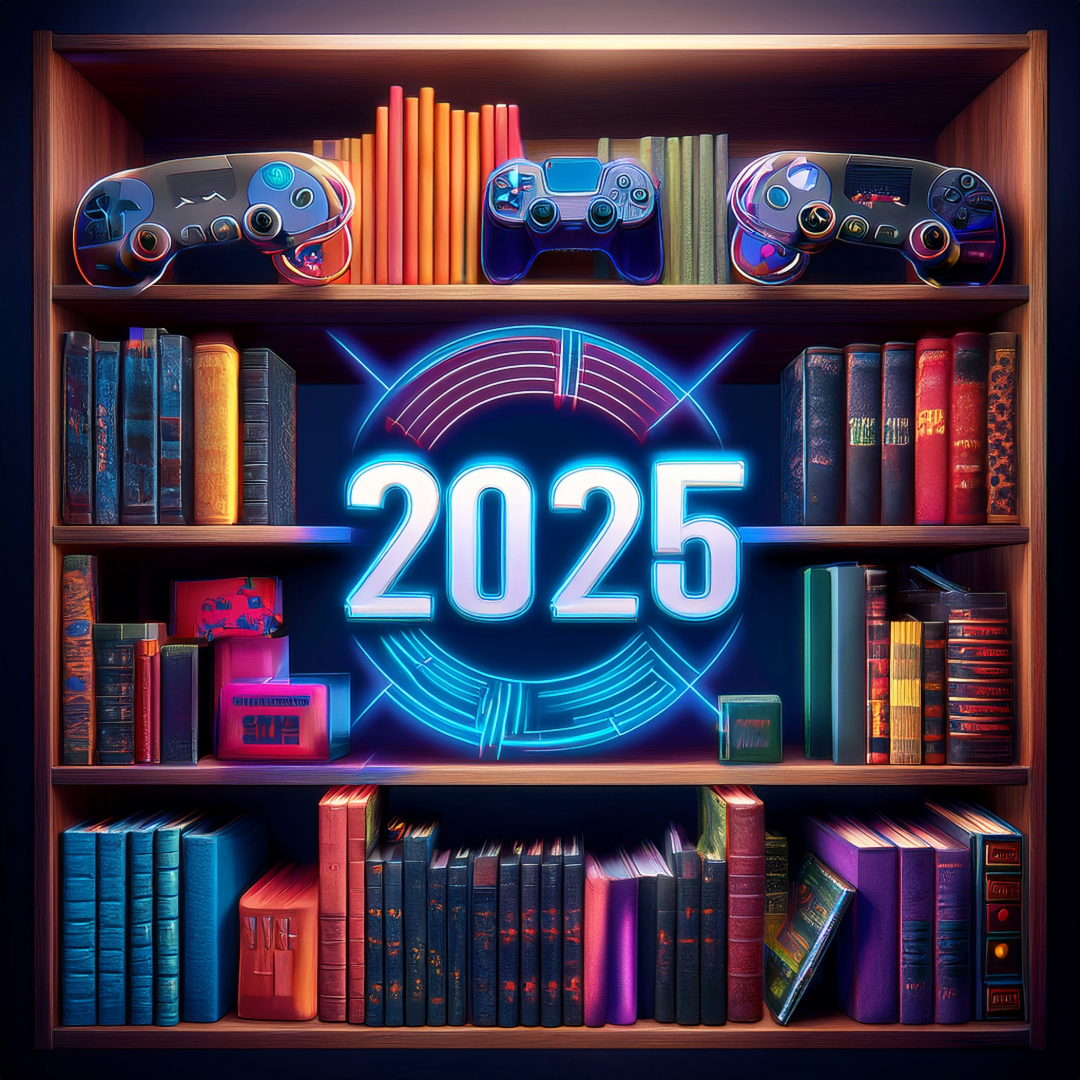Most Anticipated Games of Late 2025/2026: What to Prepare Your Rig For
1. Introduction: The Next Wave is Coming – Is Your PC Ready?
The digital horizon shimmers with promise. Whispers of returning legends like Grand Theft Auto 6 and The Elder Scrolls 6 mingle with the roar of new beasts in Monster Hunter Wilds and the fantastical reboot of Fable. For PC gamers and builders, this upcoming wave of releases, spanning late 2025 through 2026 and beyond, represents not just countless hours of potential entertainment, but also a significant technological benchmark. The excitement is palpable, the hype trains are leaving the station – but amidst the anticipation, a crucial question arises: is your gaming rig prepared for what’s next?
This article serves as a crucial briefing for the battles ahead. We will delve into some of the most eagerly awaited PC titles slated for release in the late 2025 to 2026 timeframe. We’ll explore their core concepts, development teams, and, most importantly, analyze their potential hardware demands. This involves scrutinizing both officially released and credibly speculated system requirements, highlighting the trends shaping the future of PC performance. We’ll dissect the increasing importance of technologies like real-time ray tracing, AI-powered upscaling (NVIDIA DLSS, AMD FSR), frame generation, and advanced storage APIs like DirectStorage.
The challenge facing gamers and builders is undeniable. AAA game development continues to push visual boundaries, demanding more powerful CPUs, GPUs with substantial VRAM, ample system memory, and fast storage solutions. Navigating the hardware market requires understanding not just raw power, but also the impact of these sophisticated software technologies that are becoming increasingly vital for achieving target frame rates and resolutions. This report aims to equip you with the knowledge needed to make informed decisions, whether you’re planning a strategic upgrade or building a new machine from the ground up.
To provide a quick overview of the titles central to this discussion, the table below summarizes key details:
Table 1: Anticipated Games Overview (Late 2025 – 2026+)
| Game Title | Genre | Developer | Publisher | Engine (Notable) | Est. PC Release Window | Key Feature Highlight |
|---|---|---|---|---|---|---|
| Grand Theft Auto 6 | Action-Adventure | Rockstar Games | Rockstar Games | RAGE (Updated) | Early-Mid 2026 (Spec.) | Return to Vice City, next-gen open-world simulation |
| The Elder Scrolls 6 | Action RPG | Bethesda Game Studios | Xbox Game Studios | Creation Engine 2 | 2026 / 2027+ (Spec.) | Next chapter in the epic fantasy saga, new Tamriel region |
| The Witcher 4 (Project Polaris) | Action RPG | CD Projekt Red | CD Projekt Red | Unreal Engine 5 | 2027+ (Spec.) | New Witcher saga begins, Ciri potentially protagonist |
| Monster Hunter Wilds | Action RPG | Capcom | Capcom | RE Engine | Feb 28, 2025 (Released) | Seamless open world, dynamic ecosystems, cross-play |
| Fable (2026) | Action RPG | Playground Games | Xbox Game Studios | ForzaTech | 2026 | Reboot of the beloved series, Albion reimagined, humor |
| Death Stranding 2: On The Beach | Action-Adventure | Kojima Productions | Sony (PS5) / TBD (PC) | Decima Engine | Late 2025 / 2026 (Spec.) | Sequel to Kojima’s unique vision, expanded world/mech. |
| Crimson Desert | Action-Adventure | Pearl Abyss | Pearl Abyss | BlackSpace Engine | Late 2025 | Open-world adventure in Pywel, mercenary narrative |
| Judas | First-Person Shooter | Ghost Story Games | Ghost Story Games | Unreal Engine | Late 2025 / 2026? (Spec.) | Narrative FPS from Ken Levine, roguelike elements |
| STARSEEKER: Astroneer Expeditions | Action-Adv./Sandbox | System Era Softworks | Devolver Digital | Custom (Astroneer) | 2026 | Cooperative space exploration, station hub, new tech |
2. Gearing Up for Glory: Most Anticipated PC Titles (Late 2025-2026)
Let’s examine the contenders individually, exploring what they promise and what they might demand from our hardware.
Grand Theft Auto 6: Return to Vice City
- Quick Facts:
- Genre: Action-Adventure
- Developer: Rockstar Games
- Publisher: Rockstar Games
- Engine: RAGE (Reportedly Updated)
- Estimated PC Release Window: Early-Mid 2026 (Speculative)
- What to Expect: The titan returns. Grand Theft Auto 6 marks the franchise’s comeback to the neon-soaked streets of Vice City, promising a leap forward in open-world immersion and interactive storytelling. Following the unprecedented success of GTA V, expectations are astronomical for advancements in AI, physics, environmental detail, and online components. The first trailer, confirmed to be using in-engine footage, showcased stunning visuals and a vibrant, chaotic world.
- The Hardware Toll: System Requirements
- Status: Highly Speculative. Rockstar has only confirmed a Fall 2025 release for PS5 and Xbox Series X|S. A PC version is expected later, likely in early to mid-2026, following Rockstar’s historical release pattern. The requirements below are based on educated guesses considering current trends and potential engine upgrades.
| Specification Level | CPU | GPU | RAM | VRAM | Storage | OS | Notes |
|---|---|---|---|---|---|---|---|
| Minimum (Est.) | Intel Core i5-10400F / AMD Ryzen 5 5600X | Nvidia GTX 1660 Super / AMD RX 5700 | 16 GB | 6-8 GB | 150-200 GB SSD | Windows 10/11 | Target: 1080p/30-60fps Low/Medium settings. Based on. |
| Recommended (Est.) | Intel Core i7-11700K / AMD Ryzen 7 5800X | Nvidia RTX 3080 / AMD RX 6800 XT | 16-32 GB | 10-12 GB | 150-200 GB SSD | Windows 11 | Target: 1080p/1440p 60fps High settings. Based on. |
| Ultra (Est.) | Intel Core i9-13900K / AMD Ryzen 9 7900X | Nvidia RTX 4080 / RTX 5080 / AMD RX 7900 XTX | 32 GB | 16 GB+ | 150-200 GB NVMe | Windows 11 | Target: 4K/60fps+ Ultra settings, possibly RT. Based on. |
* **Analysis:** These speculative requirements suggest a significant jump from GTA V. A mandatory SSD and a hefty install size (potentially up to 200 GB) seem almost certain.[11, 12] 16 GB of RAM appears likely as a minimum, pushing towards 32 GB for higher settings. The GPU requirements reflect the need for substantial VRAM and processing power, especially if advanced ray tracing features are implemented. The typical delay between console and PC launch for Rockstar titles often results in a more polished PC version with potentially higher requirements but also more graphical options and optimizations.[7, 10] This delay allows Rockstar to refine the PC port and incorporate newer technologies that might mature after the initial console release.
- Tech Advantage: Next-Gen Features
- The updated RAGE engine is expected to deliver major visual upgrades. Recent updates to GTA V on PC introduced Ray-Traced Global Illumination (RTGI), Ambient Occlusion, and support for NVIDIA DLSS and AMD FSR. This strongly suggests GTA 6 on PC will leverage these technologies extensively. Support for DLSS/FSR will be crucial for maintaining playable frame rates, especially if ray tracing is implemented comprehensively. DirectStorage support is also plausible, given its inclusion in the GTA V update , potentially improving loading times on NVMe SSDs.
The Elder Scrolls 6: Tamriel Awaits (Again)
- Quick Facts:
- Genre: Action RPG
- Developer: Bethesda Game Studios
- Publisher: Xbox Game Studios
- Engine: Creation Engine 2
- Estimated PC Release Window: 2026 or later (Likely 2027+)
- What to Expect: Announced way back in 2018, the successor to the legendary Skyrim remains shrouded in mystery, but anticipation is immense. Bethesda has confirmed the game entered early development after Starfield‘s launch, with internal teams playing early builds. Speculation points towards Hammerfell or High Rock as potential locations, suggesting vast deserts, mountainous terrains, or regions steeped in political intrigue. Expect the signature Elder Scrolls blend of open-world exploration, deep lore, character customization, and emergent gameplay, powered by an evolved engine.
- The Hardware Toll: System Requirements
- Status: Highly Speculative. With a release potentially years away (2026 at the absolute earliest, possibly 2027-2030) , any current requirements are pure conjecture based on Starfield and future hardware projections.
| Specification Level | CPU | GPU | RAM | VRAM | Storage | OS | Notes |
|---|---|---|---|---|---|---|---|
| Minimum (Est.) | Intel Core i5-10600K / AMD Ryzen 5 3600X | Nvidia RTX 2070 / AMD RX 6700 | 16 GB | 8 GB | 125 GB+ SSD | Windows 10/11 | Target: 1080p/30-60fps Low/Medium. Based on Starfield reqs & future trends. |
| Recommended (Est.) | Intel Core i7-12700K / AMD Ryzen 7 5800X | Nvidia RTX 3080 / AMD RX 6800 XT | 16-32 GB | 10-12 GB | 125 GB+ SSD | Windows 11 | Target: 1440p/60fps High. Based on Starfield reqs & future trends. |
| Ultra (Est.) | Intel Core i9-13900K / AMD Ryzen 9 7900X | Nvidia RTX 4080 / RTX 5080 / AMD RX 7900 XTX | 32 GB | 16 GB+ | 125 GB+ NVMe | Windows 11 | Target: 4K/60fps+ Ultra, potential RT. Based on future projections. |
* **Analysis:** Expect requirements significantly higher than *Skyrim*. Based on *Starfield*'s use of Creation Engine 2, an SSD will likely be mandatory. 16 GB RAM seems a safe bet for minimum/recommended, potentially rising for ultra settings.[19] GPU demands will depend heavily on the final visual fidelity and optimization, but aiming for hardware beyond *Starfield*'s recommended specs (RTX 2080 / RX 6700 XT) seems prudent for a good experience upon release several years from now. The long development cycle means final specs could target hardware generations not yet released.
- Tech Advantage: Next-Gen Features
- The Elder Scrolls 6 will utilize Creation Engine 2, the same engine powering Starfield but likely with significant upgrades developed over the intervening years. Bethesda invested heavily in overhauling the engine, focusing on advanced photogrammetry, improved physics, lighting, animations, and optimization for current-gen consoles and PCs. While Starfield didn’t feature ray tracing at launch, advancements in the engine and the later release date make RT features like global illumination or reflections more plausible for TES6. Support for upscaling technologies like DLSS and FSR seems highly likely to manage performance in such a potentially vast and detailed world.
The Witcher 4 (Project Polaris): A New Saga Begins
- Quick Facts:
- Genre: Action RPG
- Developer: CD Projekt Red
- Publisher: CD Projekt Red
- Engine: Unreal Engine 5
- Estimated PC Release Window: 2027 or later
- What to Expect: The first installment in a new Witcher trilogy, Project Polaris (unofficially The Witcher 4) aims to push the boundaries of RPGs. CD Projekt Red officially revealed the game at The Game Awards 2024 with a stunning cinematic trailer focusing on Geralt’s adoptive daughter, Ciri, facing a fearsome monster called a Bauk. While Ciri’s role as the sole protagonist isn’t confirmed, her prominence and the teaser image featuring a Lynx School medallion suggest a departure from Geralt’s story. Development is in “full production” with a large team assigned.
- The Hardware Toll: System Requirements
- Status: Highly Speculative. With a release confirmed to be no earlier than 2027 , these requirements are projections based on UE5 capabilities and future hardware expectations.
| Specification Level | CPU | GPU | RAM | VRAM | Storage | OS | Notes |
|---|---|---|---|---|---|---|---|
| Minimum (Est.) | Intel Core i5-11600K / AMD Ryzen 5 5600X | Nvidia RTX 3060 (12GB) / AMD RX 6700 XT (12GB) | 16 GB | 12 GB | 150-200 GB SSD | Windows 10/11 | Target: 1080p/30-60fps Low/Medium. Based on & UE5 baseline. |
| Recommended (Est.) | Intel Core i5-13600K / AMD Ryzen 5 7600X | Nvidia RTX 4070 (12GB) / AMD RX 6800 XT (16GB) | 24 GB | 12-16 GB | 150-200 GB SSD | Windows 11 | Target: 1080p/1440p 60fps High, potential RT. Based on. |
| Ultra (Est.) | Intel Core i9-14900K / AMD Ryzen 7 7800X3D | Nvidia RTX 4080 / RTX 5080 / AMD RX 7900 XTX / 8800 XT | 32-48 GB | 16 GB+ | 150-200 GB NVMe | Windows 11 | Target: 4K/60fps+ Ultra, extensive RT. Based on & future hardware. |
* **Analysis:** Built on Unreal Engine 5, expect demanding requirements leveraging features like Nanite and Lumen. The speculative figures point towards needing powerful hardware even for baseline experiences.[25] High VRAM (12GB+ minimum) and substantial RAM (16GB minimum, 24GB+ recommended) seem likely. The large projected storage size (200 GB) reflects the potential scale and detail of the world.[25] Given the 2027+ timeframe, these specs might even underestimate the final demands, potentially targeting hardware beyond the RTX 40/RX 7000 series for optimal play.
- Tech Advantage: Next-Gen Features
- The shift from CDPR’s REDengine to Unreal Engine 5 is significant. This provides access to UE5’s cutting-edge features like Nanite virtualized geometry and Lumen dynamic global illumination, promising incredibly detailed environments and realistic lighting without traditional performance trade-offs (though UE5 games can still be demanding). Extensive ray tracing support is highly probable. Given CDPR’s history with Cyberpunk 2077, robust support for NVIDIA DLSS (including Frame Generation) and AMD FSR is almost guaranteed and will likely be essential for running the game smoothly at higher settings, especially with ray tracing enabled.
Monster Hunter Wilds: The Hunt Evolves
- Quick Facts:
- Genre: Action RPG
- Developer: Capcom
- Publisher: Capcom
- Engine: RE Engine
- Estimated PC Release Window: February 28, 2025 (Released)
- What to Expect: Building on the massive success of Monster Hunter: World, Wilds takes the hunt to the next level. It features vast, seamless open-world environments with dynamic weather systems and interacting monster ecosystems. Players utilize new traversal options with the bird-like Seikret mount, which can also carry a second weapon for mid-hunt swaps. All 14 weapon types return with new moves, alongside features like pop-up camps and a “focus mode” for targeting weak points. Crucially, Wilds is the first mainline title with simultaneous launch across PC and consoles, featuring full cross-platform play.
- The Hardware Toll: System Requirements
- Status: Official. Capcom released detailed specs and a benchmark tool prior to launch.
| Specification Level | CPU | GPU | RAM | VRAM | Storage | OS | Notes |
|---|---|---|---|---|---|---|---|
| Minimum (Lowest) | Intel Core i5-10600 / i3-12100F / AMD Ryzen 5 3600 | Nvidia GTX 1660 Super / AMD RX 5600 XT | 16 GB | 6 GB | 140 GB SSD | Windows 10/11 | Target: 1080p (720p Native Upscaled) / 30fps @ Lowest settings. DirectStorage supported. |
| Recommended (Medium) | Intel Core i5-10400 / i3-12100 / AMD Ryzen 5 3600 | Nvidia RTX 2060 Super / AMD RX 6600 | 16 GB | 8 GB | 75 GB SSD | Windows 10/11 | Target: 1080p (Upscaled) / 60fps @ Medium settings with Frame Generation enabled. DirectStorage. |
| Recommended (Alt) | Intel Core i5-11600K / i5-12400 / AMD Ryzen 5 3600X / 5500 | Nvidia RTX 2070 Super / RTX 4060 / AMD RX 6700 XT | 16 GB | 8-12 GB | 140 GB SSD | Windows 10/11 | Target: 1080p / 60fps @ Medium settings with Frame Generation enabled. DirectStorage. |
* **Analysis:** The official requirements highlight several key trends. An SSD is mandatory, even for minimum settings.[30, 31] 16 GB RAM is the baseline.[30, 31] The GPU requirements are notable: even the minimum targets 30fps using upscaling from 720p.[31] Critically, the recommended specs explicitly state their 60fps target relies on **Frame Generation being enabled**.[30, 31] This underscores how integral upscaling and frame generation technologies are becoming for achieving target performance levels in modern demanding titles, shifting from optional enhancements to near-necessities for the intended experience at medium-to-high settings. The VRAM requirement also jumps from 6GB minimum to 8GB+ recommended.
- Tech Advantage: Next-Gen Features
- Monster Hunter Wilds leverages Capcom’s versatile RE Engine. It supports Ray Tracing (though performance impact requires careful consideration), NVIDIA DLSS (up to version 3.7 or newer via overrides), AMD FSR (up to 3.1), and crucially, Frame Generation for both NVIDIA (DLSS 3 FG) and AMD (FSR 3 FG). It also implements Microsoft DirectStorage, which aims to improve loading times and potentially asset streaming performance by allowing direct communication between the SSD and GPU, bypassing CPU decompression bottlenecks. NVIDIA Reflex is also supported for latency reduction.
Fable (2026): Albion’s Next Chapter
- Quick Facts:
- Genre: Action RPG
- Developer: Playground Games (with Eidos-Montréal support)
- Publisher: Xbox Game Studios
- Engine: ForzaTech
- Estimated PC Release Window: 2026
- What to Expect: A full reboot of the beloved British fantasy RPG series, Fable aims to recapture the original’s unique blend of charm, humor, and consequence-driven gameplay for a new generation. Developed by the acclaimed studio behind the Forza Horizon series, Playground Games, the reboot promises a visually stunning rendition of Albion. Pre-alpha footage showcased exploration, combat against creatures like hobbes and werewolves, the return of iconic elements like giant chickens, and hints of the series’ signature quirky humor featuring actors like Richard Ayoade and Matt King.
- The Hardware Toll: System Requirements
- Status: Unknown / Speculative. No official requirements have been released. The game was delayed from 2025 to 2026 to allow for more development time.
| Specification Level | CPU | GPU | RAM | VRAM | Storage | OS | Notes |
|---|---|---|---|---|---|---|---|
| Minimum (Est.) | Intel Core i5-11600K / AMD Ryzen 5 5600X | Nvidia RTX 2070 / AMD RX 6700 XT | 16 GB | 8 GB | 100 GB+ SSD | Windows 10/11 | Target: 1080p/30-60fps Low/Medium. Based on engine capabilities & 2026 release. |
| Recommended (Est.) | Intel Core i7-13700K / AMD Ryzen 7 7700X | Nvidia RTX 3080 / RTX 4070 / AMD RX 6800 XT / 7800 XT | 16-32 GB | 12 GB+ | 100 GB+ SSD | Windows 11 | Target: 1440p/60fps High. Based on engine capabilities & 2026 release. |
| Ultra (Est.) | Intel Core i9-14900K / AMD Ryzen 9 7950X3D | Nvidia RTX 4080 / RTX 5080 / AMD RX 7900 XTX | 32 GB | 16 GB+ | 100 GB+ NVMe | Windows 11 | Target: 4K/60fps+ Ultra, potential RT. Based on engine capabilities & future hardware. |
* **Analysis:** Given Playground Games' expertise in creating visually stunning open worlds with the ForzaTech engine, expect *Fable* to be graphically demanding.[34, 37] The engine is known for its impressive environments, physics, and weather systems.[40] While adapted for an RPG, the core technology suggests high requirements for detailed textures, lighting, and draw distances. An SSD will undoubtedly be required. 16 GB RAM is likely minimum, with 32 GB potentially beneficial for higher settings. VRAM requirements could easily hit 8GB minimum and 12GB+ recommended, especially if ray tracing is implemented. The 2026 release date provides time for optimization but also means targeting potentially newer hardware. The use of ForzaTech, an engine primarily designed for racing games, for a complex open-world RPG presents an interesting variable; while it excels at certain visual aspects, its adaptation for RPG systems (character models, complex AI, inventory, etc.) is untested at this scale.[40, 41]
- Tech Advantage: Next-Gen Features
- The ForzaTech engine has already incorporated features like ray tracing in Forza Motorsport. It’s highly probable that Fable will leverage ray tracing for enhanced lighting, shadows, and reflections to create the “most beautifully realized version of Albion”. Support for DLSS and FSR is likely, given Microsoft’s increasing adoption of these technologies in first-party titles to ensure broad hardware compatibility and performance scaling. DirectStorage is also a possibility for optimizing load times on PC and Xbox Series X/S.
Death Stranding 2: On The Beach: Connecting Again
- Quick Facts:
- Genre: Action-Adventure
- Developer: Kojima Productions
- Publisher: Sony Interactive Entertainment (PS5) / TBD (PC Speculative)
- Engine: Decima Engine
- Estimated PC Release Window: Late 2025 / 2026 (Speculative, following June 26, 2025 PS5 release)
- What to Expect: The sequel to Hideo Kojima’s enigmatic 2019 title, Death Stranding 2: On the Beach continues the journey of Sam Porter Bridges (Norman Reedus) in a world fractured by supernatural events. Trailers showcase familiar faces like Fragile (Léa Seydoux) and Higgs (Troy Baker), alongside new characters and bizarre phenomena, including puppet-like companions and massive, otherworldly threats. Expect an expansion of the core “strand” gameplay mechanics, potentially more dynamic combat, new environments beyond the UCA, and Kojima’s signature blend of complex narrative, surrealism, and cinematic presentation.
- The Hardware Toll: System Requirements
- Status: Highly Speculative. The game launches first on PS5 on June 26, 2025. While the original Death Stranding received a PC port relatively quickly (developed in-house by Kojima Productions ), a PC version of DS2 hasn’t been officially confirmed, let alone its requirements. Specs below are projections based on the first game’s Director’s Cut, Decima engine advancements, and the 2025/2026 timeframe.
| Specification Level | CPU | GPU | RAM | VRAM | Storage | OS | Notes |
|---|---|---|---|---|---|---|---|
| Minimum (Est.) | Intel Core i5-11600K / AMD Ryzen 5 5600X | Nvidia RTX 3060 (12GB) / AMD RX 6700 XT (12GB) | 16 GB | 8-12 GB | 150 GB SSD | Windows 10/11 | Target: 1080p/60fps Medium/High. Based on & engine potential. |
| Recommended (Est.) | Intel Core i5-13600K / AMD Ryzen 5 7600X | Nvidia RTX 4070 (12GB) / AMD RX 7800 XT (16GB) | 24 GB | 12-16 GB | 150 GB SSD | Windows 11 | Target: 1440p/60fps High, potential RT. Based on. |
| Ultra (Est.) | Intel Core i9-14900K / AMD Ryzen 7 7800X3D | Nvidia RTX 4080 / RTX 5090 / AMD RX 7900 XTX / 9070 XT | 32-48 GB | 16-24 GB+ | 150 GB NVMe | Windows 11 | Target: 4K/60fps+ Ultra, RT enabled. Based on & future hardware. |
* **Analysis:** The Decima engine, co-developed with Guerrilla Games, is known for producing stunning visuals and detailed open worlds, as seen in *Horizon Forbidden West* and the original *Death Stranding*.[45, 52, 53] DS2 will push this engine further. Expect high demands for texture quality and draw distance, necessitating significant VRAM (potentially 12GB+ recommended) and likely 16GB RAM minimum, pushing higher for ultra.[46] An SSD will be essential, with a large install size probable.[46] The potential inclusion of ray tracing could significantly increase GPU load.
- Tech Advantage: Next-Gen Features
- The original Death Stranding on PC was lauded for its excellent implementation of DLSS 2.0, offering significant performance boosts with image quality often superior to native TAA. The Director’s Cut later added support for FSR 2.0 and Intel XeSS. It’s almost certain DS2 will feature the latest versions of DLSS, FSR, and potentially XeSS. While the first game did not use ray tracing , reports and visual analysis suggest DS2 will incorporate ray tracing features, likely for reflections and possibly global illumination, further leveraging the Decima engine’s capabilities on PS5 and potentially high-end PCs.
Crimson Desert: Sands of Change
- Quick Facts:
- Genre: Open World Action-Adventure
- Developer: Pearl Abyss
- Publisher: Pearl Abyss
- Engine: BlackSpace Engine
- Estimated PC Release Window: Late 2025
- What to Expect: From the creators of the popular MMO Black Desert Online, Crimson Desert is an ambitious single-player (with potential co-op elements) open-world action-adventure. Set on the continent of Pywel, players follow the journey of a mercenary named Kliff caught in unfolding conflicts. The game promises a vast, detailed world powered by Pearl Abyss’s next-generation proprietary BlackSpace Engine, featuring intricate combat, exploration, and potentially complex simulation elements.
- The Hardware Toll: System Requirements
- Status: Official (Potentially Revised). Pearl Abyss released official minimum and recommended specs, though there were reports of the recommended GPU being revised downwards shortly after initial posting. The target resolution/settings for these specs were not initially specified, leading to some ambiguity.
| Specification Level | CPU | GPU | RAM | VRAM | Storage | OS | Notes |
|---|---|---|---|---|---|---|---|
| Minimum | Intel Core i5-8500 / AMD Ryzen 5 2600X | Nvidia GTX 1060 / AMD RX 6500 XT | 16 GB | 4-6 GB | 100 GB SSD | Windows 10 64-bit | Target: Unknown (Likely 1080p/30fps Low). SSD likely required despite not explicitly stated. |
| Recommended | Intel Core i7-13700K / AMD Ryzen 7 7700X | Nvidia RTX 2080 / AMD RX 6700 XT | 16 GB | 8-12 GB | 100 GB SSD | Windows 10 64-bit | Target: Unknown (Possibly 1080p/1440p 60fps High). Initial spec reportedly listed RTX 4070 Super. |
| Ultra (Est.) | Intel Core i7-14700K / AMD Ryzen 7 7800X3D | Nvidia RTX 4080 / RTX 5070 / AMD RX 7900 XTX | 32 GB | 16 GB+ | 100 GB SSD | Windows 11 | Target: 1440p/4K 60fps+ Ultra, RT enabled. Based on & engine features. |
* **Analysis:** The official minimum specs are relatively modest for a late 2025 title, targeting older mid-range hardware like the GTX 1060.[59, 62] However, the recommended specs jump significantly, especially on the CPU side (13th Gen Intel / Ryzen 7000).[59, 62] The reported revision of the recommended GPU from an RTX 4070 Super down to an RTX 2080 / RX 6700 XT [62] creates uncertainty about the intended performance target. It's possible the lower spec targets 1080p/1440p High, while the originally listed higher spec was for 4K or Ultra settings. Regardless, 16 GB RAM and 100 GB of storage are standard.[59, 62] The ambiguity surrounding the recommended spec target highlights a common issue where developers release requirements without clearly stating the expected resolution, framerate, and quality settings.
- Tech Advantage: Next-Gen Features
- The BlackSpace Engine is touted as a significant leap over the engine used for Black Desert Online, designed specifically for highly detailed open worlds. Tech demos showcased real-time physics and destructibility, volumetric fog, dynamic weather, real-time lighting, advanced cloth/hair simulation, and support for ray tracing. Pearl Abyss has confirmed support for AMD FSR 3 , making support for NVIDIA DLSS and Intel XeSS highly probable as well. These upscaling technologies will likely be crucial for enabling ray tracing and maintaining smooth performance in the dense, dynamic world Pearl Abyss aims to deliver.
Judas: BioShock’s Spiritual Successor?
- Quick Facts:
- Genre: Narrative First-Person Shooter
- Developer: Ghost Story Games
- Publisher: Ghost Story Games
- Engine: Unreal Engine (Likely UE5 given timeframe/visuals)
- Estimated PC Release Window: Uncertain (Previously “by March 2025”, now likely Late 2025 / 2026+)
- What to Expect: Helmed by Ken Levine, the creator of BioShock, Judas is a narrative-driven FPS set aboard a disintegrating generation starship, the Mayflower. Players control the titular Judas, whose actions disrupt the ship’s controlled society. The game features a unique “Narrative LEGOs” system where player choices dynamically build the story, influencing character relationships and events. It also incorporates roguelike elements, with the player character being reconstructed after death and the ship potentially restructuring itself.
- The Hardware Toll: System Requirements
- Status: Highly Speculative / Potentially Misleading. Some sources list extremely low requirements , but these seem to refer to a different, unrelated 2017 indie game also titled Judas. There are no credible official or speculative requirements for Ken Levine’s Judas currently available. Requirements below are pure conjecture based on a potential UE5 foundation and late 2025/2026 release.
| Specification Level | CPU | GPU | RAM | VRAM | Storage | OS | Notes |
|---|---|---|---|---|---|---|---|
| Minimum (Est.) | Intel Core i5-10600K / AMD Ryzen 5 3600X | Nvidia RTX 2060 / AMD RX 5700 XT | 16 GB | 6-8 GB | 80 GB+ SSD | Windows 10/11 | Target: 1080p/60fps Low/Medium. Pure speculation assuming modern engine/release date. |
| Recommended (Est.) | Intel Core i7-12700K / AMD Ryzen 7 5800X | Nvidia RTX 3070 / AMD RX 6800 | 16 GB | 8-10 GB | 80 GB+ SSD | Windows 11 | Target: 1440p/60fps High. Pure speculation. |
| Ultra (Est.) | Intel Core i9-13900K / AMD Ryzen 7 7800X3D | Nvidia RTX 4070 Ti / RTX 5070 / AMD RX 7900 XT | 32 GB | 12 GB+ | 80 GB+ NVMe | Windows 11 | Target: 4K/60fps+ Ultra, potential RT. Pure speculation. |
* **Analysis:** The lack of official specs, combined with the initial "by March 2025" window passing without a release or firm date [68, 69, 71], makes requirement prediction difficult. If the game uses a modern version of Unreal Engine (likely UE5 given the visuals and development time), expect requirements in line with other contemporary UE5 titles. This would imply needing a reasonably modern CPU, 16GB RAM minimum, and a GPU with 8GB+ VRAM for a good experience. The ambiguity surrounding its release date and specs makes planning difficult for potential players.
- Tech Advantage: Next-Gen Features
- Assuming the use of Unreal Engine 5, Judas could potentially leverage features like Nanite and Lumen for detailed environments and lighting. Ray tracing support is plausible. Given the engine, support for DLSS, FSR, and potentially Intel XeSS is highly likely and would be beneficial for performance, especially if ray tracing is implemented. The visual style seen in trailers suggests a focus on atmospheric lighting and detailed character models, areas where these technologies excel.
STARSEEKER: Astroneer Expeditions: Beyond the Home Planet
- Quick Facts:
- Genre: Action-Adventure / Sandbox / Multiplayer
- Developer: System Era Softworks
- Publisher: Devolver Digital
- Engine: Custom (Likely based on Astroneer’s tech)
- Estimated PC Release Window: 2026
- What to Expect: Set in the same universe as the charming survival sandbox Astroneer, STARSEEKER is explicitly not a direct sequel but a new experience focused on multiplayer cooperation. Players join the crew of the ESS Starseeker space station, embarking on cooperative expeditions across multiple star systems to complete planet-wide objectives using “cutting edge technology”. Expect exploration, facing strange creatures and hazards, and collaborative gameplay centered around the evolving space station hub.
- The Hardware Toll: System Requirements
- Status: Unknown / To Be Determined. The Steam page currently lists requirements as “TBD”. Requirements below are speculative, based loosely on the original Astroneer but factoring in a 2026 release and potentially increased scope/fidelity.
| Specification Level | CPU | GPU | RAM | VRAM | Storage | OS | Notes |
|---|---|---|---|---|---|---|---|
| Minimum (Est.) | X64 Quad Core CPU, 3+ GHz | Discrete GPU w/ 4 GB RAM (e.g., GTX 1650) | 8 GB | 4 GB | 20 GB+ SSD | Windows 10/11 | Target: 1080p/60fps Low/Medium. Based on Astroneer recs + moderate increase. |
| Recommended (Est.) | Intel Core i5-10400 / AMD Ryzen 5 3600 | Nvidia GTX 1660 Super / AMD RX 5600 XT | 16 GB | 6 GB | 20 GB+ SSD | Windows 11 | Target: 1080p/60fps High. Moderate increase over Astroneer, considering 2026 release. |
| Ultra (Est.) | Intel Core i7-11700 / AMD Ryzen 7 5700X | Nvidia RTX 3060 / AMD RX 6600 XT | 16 GB | 8 GB | 20 GB+ SSD | Windows 11 | Target: 1440p/60fps+ Ultra. Speculation on higher fidelity/scope than original. |
* **Analysis:** The original *Astroneer* was relatively accessible, with recommended specs calling for a quad-core CPU, 8GB RAM, and a discrete GPU with 2GB VRAM.[82] However, players noted performance could degrade, especially with complex bases or extensive terrain manipulation, and 8GB RAM was sometimes insufficient.[85] *STARSEEKER*, releasing in 2026 and potentially featuring larger scale environments and more complex systems for multiplayer, will likely require more robust hardware. 16GB RAM seems probable for recommended specs. While the stylized visuals might not demand cutting-edge GPUs for baseline performance, achieving smooth frame rates in potentially busy multiplayer scenarios could still require mid-range hardware from recent generations. An SSD is highly recommended for smoother asset loading.
- Tech Advantage: Next-Gen Features
- Details are scarce, beyond the mention of “cutting edge technology”. Given the stylized visuals, extensive ray tracing seems unlikely. However, support for upscaling technologies like DLSS and FSR could be implemented to improve performance, especially on lower-end hardware or at higher resolutions, ensuring a smoother experience during cooperative play. The focus on multiplayer might also lead to optimizations targeting network performance and simulation handling across multiple players.
3. Reading the Tech Tea Leaves: Hardware Trends for 2026 Gaming
Analyzing the requirements—both official and speculative—for this upcoming slate of major PC titles reveals distinct shifts in hardware expectations compared to the standards of just a few years ago. Gamers and builders planning for the late 2025/2026 landscape need to be aware of these evolving demands.
- CPU: The Brains Get Bigger: Single-core performance remains important, but the baseline is shifting towards CPUs with higher core counts and modern architectures. Minimum requirements frequently land on chips like the AMD Ryzen 5 3600/5600X or Intel Core i5 10th/11th generation, processors that offer 6 cores and 12 threads. Recommended specs often push into Ryzen 7000 or Intel 13th/14th generation territory, indicating that newer architectures and potentially 8+ cores are becoming desirable for smoother performance, especially in complex open-world games with sophisticated AI and simulation systems like those anticipated in GTA 6 or The Elder Scrolls 6.
- GPU: VRAM is King, Performance is Paramount: This remains the most critical component for gaming, and the demands are escalating rapidly.
- VRAM: 8GB of VRAM is solidifying as the absolute minimum for many upcoming AAA titles at 1080p, replacing the older 4GB/6GB standard. Recommended specifications frequently call for 12GB or even 16GB, particularly for 1440p or higher resolutions, or when enabling ray tracing. This surge is driven by increasingly detailed textures, complex shader effects, and the significant memory footprint of ray tracing data structures.
- Performance Tiers: Entry-level gaming at 1080p/low settings might still be possible with cards like the GTX 1660 Super or RX 5600 XT/6500 XT for some titles. However, achieving a recommended experience (often 1080p/1440p at 60fps with medium-to-high settings) increasingly requires GPUs in the class of the RTX 20-series Super / RTX 3060 / RX 6600 XT / RX 6700 XT or better. Pushing to high resolutions (1440p high refresh, 4K) or enabling demanding ray tracing effects necessitates powerful modern cards like the RTX 3080/4070 Ti and above, or their AMD equivalents (RX 6800 XT/7800 XT and up), and potentially even future generations like the speculative RTX 50-series or RX 8000/9000 series for the most demanding titles like The Witcher 4 or GTA 6 at max settings.
- RAM: 16GB is the New Normal, 32GB the New Comfort Zone: The era of 8GB RAM being sufficient for gaming is definitively over for new AAA releases. 16GB is now the standard minimum requirement across the board for most anticipated titles, and often suffices for recommended settings as well. However, there’s a clear trend towards higher capacities for optimal performance, particularly at higher settings or resolutions. Speculative requirements for ultra settings in games like The Witcher 4 or Death Stranding 2 reach into 24GB, 32GB, or even 48GB territory. This reflects the needs of larger, more detailed game worlds, increased asset streaming, and potentially more background processes. While 16GB will likely get you in the door, 32GB is rapidly becoming the recommended capacity for enthusiasts seeking a smooth experience without needing to meticulously manage background applications, representing a noticeable “RAM creep” in system requirements.
- Storage: SSD Mandatory, Speed Matters (Sometimes): Mechanical hard drives (HDDs) are no longer viable for primary gaming storage in the AAA space. SSDs are universally required, even for minimum specifications, due to the need for faster loading times and asset streaming demanded by large, detailed open worlds. Install sizes are also ballooning, with 100GB becoming commonplace and titles like GTA 6 or The Witcher 4 potentially demanding 150-200GB. The emergence of technologies like Microsoft DirectStorage, supported by games like Monster Hunter Wilds and potentially GTA 6 , introduces a potential new layer. DirectStorage allows GPUs to directly access SSD data, bypassing CPU bottlenecks for faster loading and potentially smoother streaming. While not yet universally adopted or proven to provide massive gains in all scenarios, its presence suggests that the speed of an SSD (specifically, NVMe drives benefiting most) could become a more significant factor in gaming performance beyond just initial load times for titles that effectively utilize the technology. This could lead to a stratification where faster NVMe drives offer tangible benefits over slower SATA SSDs in specific, DirectStorage-enabled games.
- The Upscaling & Frame Gen Crutch/Enhancement: Perhaps the most significant trend is the normalization of AI-powered upscaling (DLSS, FSR, XeSS) and Frame Generation technologies. Once considered optional bonuses, they are increasingly presented as integral to achieving target performance levels, especially at higher resolutions or with demanding features like ray tracing enabled. Monster Hunter Wilds‘ recommended specs explicitly tie their 60fps target to having Frame Generation active. Benchmarks and optimization guides for demanding titles heavily rely on these features. While they offer remarkable performance gains, their necessity raises questions about native performance targets and potentially masks optimization challenges. For gamers, understanding and utilizing these technologies is becoming less of a choice and more of a requirement to unlock the full potential of their hardware and the visual fidelity offered by upcoming games. This marks a paradigm shift where software assistance is factored into the expected performance equation from the outset.
Table 11: Hardware Trend Summary (Mid-2024 vs. Late 2025/2026)
| Component | Metric | Current Standard (Mid-2024 Estimate) | Emerging Trend (Late 2025/2026 Games) |
|---|---|---|---|
| CPU | Baseline | 6-Core (Ryzen 3000 / Intel 10th Gen) | 6-Core/12-Thread (Ryzen 5000 / Intel 11th Gen+) |
| Recommended | 6/8-Core (Ryzen 5000 / Intel 12th Gen) | 8-Core+ (Ryzen 7000 / Intel 13th Gen+) | |
| GPU | VRAM Minimum | 6-8 GB | 8-12 GB |
| VRAM Recommended | 8-12 GB | 12-16 GB+ | |
| Performance Tier (Rec) | RTX 3060 / RX 6600 XT level | RTX 3070/4060 Ti / RX 6700 XT/7700 XT level+ | |
| RAM | Minimum | 8-16 GB | 16 GB |
| Recommended | 16 GB | 16-32 GB+ | |
| Storage | Type | SATA SSD | NVMe SSD (Recommended/Required for some) |
| Capacity | 500GB – 1TB | 1TB – 2TB+ (due to 100-200GB installs) | |
| Technology | Standard Loading | DirectStorage Support (Emerging) |
4. Upgrade Path Activated: Preparing Your Rig for the Future
With these trends in mind, how should gamers and PC builders approach upgrades or new builds to ensure readiness for the demanding titles of late 2025 and 2026? It requires careful assessment and prioritization.
- Assessing Your Build: The first step is a realistic comparison of your current system against the emerging standards outlined above. Check your CPU generation and core count, GPU model and VRAM, total RAM capacity, and storage type/capacity. Identify the components most likely to fall short based on the requirements of the specific games you anticipate playing (refer back to Tables 2-10).
- Prioritization Puzzle: Budgets are finite, so strategic allocation is key.
- GPU: For most gaming scenarios, the graphics card remains the primary determinant of performance, especially at higher resolutions and quality settings. The increasing VRAM requirements (8GB minimum, 12GB+ recommended) and the heavy toll of ray tracing make this a likely first upgrade candidate. Consider the target resolution: 1080p might be manageable with mid-range cards (RTX 4060/RX 7600 XT level), but 1440p and 4K, especially with RT, demand high-end options (RTX 4070 Ti/RX 7800 XT and above). Importantly, the prevalence of DLSS and FSR means these technologies can significantly extend the viable lifespan of a GPU or allow a less powerful card to punch above its weight, making support for the latest versions a valuable feature.
- CPU: While often secondary to the GPU, the CPU’s role is growing, particularly in large open-world games with complex simulations and numerous NPCs (GTA 6, Elder Scrolls 6). If you’re running an older 4-core or early 6-core processor, it might bottleneck a powerful new GPU, leading to stuttering or lower-than-expected frame rates. An upgrade to a modern 6-core/12-thread or 8-core CPU (Ryzen 5000/7000 series, Intel 12th gen or newer) could be necessary to fully leverage a high-end GPU and ensure smooth gameplay in CPU-intensive titles.
- RAM: This is often one of the more cost-effective upgrades. If your system currently has 16GB, it meets the minimum/recommended baseline for most upcoming games. However, given the trend towards 24GB/32GB for higher settings and the relatively low cost compared to CPUs/GPUs, upgrading to 32GB offers significant future-proofing and headroom for multitasking while gaming. It addresses the observed “RAM creep” proactively.
- Storage: The absolute minimum is ensuring you have an SSD, preferably NVMe, as the primary drive for games. Given the massive install sizes (100-200GB), capacity becomes a major factor. Upgrading to a 1TB or 2TB NVMe SSD is advisable if you plan to install multiple large titles. While the benefits of top-tier Gen4/Gen5 NVMe speeds via DirectStorage are still emerging, investing in a reasonably fast NVMe drive provides a solid foundation and prepares for games that might leverage that speed effectively.
- Building for Longevity: When constructing a new PC or performing a major overhaul, balance is crucial, but the pressure points are clear. Prioritize a GPU with ample VRAM (12GB should be the target, 16GB+ ideal for high-end/future-proofing). Pair it with a capable modern CPU (at least 6-core/12-thread, 8-core preferred). Aim for 32GB of RAM. Ensure a fast NVMe SSD with sufficient capacity (at least 1TB, 2TB recommended). Consider waiting for next-generation components (like the RTX 50-series GPUs or equivalent AMD offerings mentioned speculatively ) if your current system is adequate for now, as these may offer better performance per dollar or necessary features for future titles. However, waiting perpetually is impractical; assess current needs against future projections.
- The Engine Factor: Remember that performance and feature support can vary based on the game engine. Unreal Engine 5 titles (Witcher 4, Judas) will likely benefit heavily from UE5-specific optimizations and features like Nanite/Lumen, and typically have strong DLSS/FSR support. Proprietary engines like Creation Engine 2 (ES6), ForzaTech (Fable), Decima (DS2), RE Engine (MHW), and BlackSpace (Crimson Desert) have their own strengths and weaknesses regarding optimization, feature implementation (like ray tracing or DirectStorage), and upscaling support. This engine specialization means performance on similar hardware can differ significantly between games.
- The Delay Factor: Game delays (Fable ) and the common practice of staggered PC releases (GTA 6 ) provide some breathing room. You don’t necessarily need hardware capable of running a 2027 game at max settings today. However, the trends are clear, and planning upgrades 6-12 months ahead of major anticipated releases is a prudent strategy.
5. Conclusion: Brace for Impact (and Incredible Gaming)
The next couple of years promise a thrilling era for PC gaming, with highly anticipated sequels, ambitious new IPs, and stunning technological advancements converging. However, this evolution comes with escalating hardware demands. The analysis of upcoming titles like Grand Theft Auto 6, The Elder Scrolls 6, The Witcher 4, and others reveals undeniable trends: CPUs need more cores, GPUs require significantly more VRAM and raw power, 16GB RAM is the new floor with 32GB becoming desirable, and fast SSD storage is non-negotiable, with capacities needing to accommodate 100-200GB installs.
Crucially, technologies like NVIDIA DLSS, AMD FSR, and associated Frame Generation techniques are transitioning from optional extras to essential tools for achieving target performance, especially when enabling demanding features like ray tracing or playing at resolutions beyond 1080p. The reliance on these technologies, as seen in official requirements like Monster Hunter Wilds‘, underscores their importance in the modern PC gaming ecosystem. Furthermore, the potential impact of APIs like DirectStorage hints at a future where storage speed might influence in-game performance more directly.
For gamers and PC builders, the path forward requires careful planning and strategic investment. Assessing current hardware against these emerging benchmarks and prioritizing upgrades – often starting with the GPU and its VRAM, followed by considerations for CPU, RAM, and storage – is crucial. While the prospect of needing powerful, potentially expensive hardware might seem daunting, the payoff is access to incredibly immersive, visually breathtaking experiences that push the boundaries of interactive entertainment.
The future of PC gaming looks demanding, yes, but also incredibly exciting. Prepare your rigs, stay informed as official specifications and benchmarks emerge closer to launch, manage expectations regarding native performance versus upscaled/generated frames, and get ready for the next wave of unforgettable digital adventures.
A Gentle Request for Your Support
We at daryo89.pro are dedicated to bringing you informative articles on the world of IT, gaming, and streaming without the interruption of sponsored advertisements. If you have found this guide helpful and would like to support our work, please consider making a small donation through the following link: https://daryo89.pro/product/support-my-work-fuel-my-creativity/. Your contribution, no matter the size, helps us continue to fuel our creativity and provide you with valuable content.












Add comment